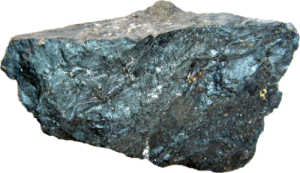Ore
An ore is a special type of rock that contains a large enough amount of a particular mineral (usually a metal) to make it economically practical to extract that mineral from the surrounding rock. Not all minerals are found in a large enough amount in one location to make it worth it to remove the ore from the rock through a process known as mining. Ores can be mined in a number of ways, including strip mining as shown here at this uranium mine. If there is a large enough amount present, the rock will be extracted and processed in a variety of ways (depending on the type of mineral) to remove the mineral from the surrounding rock. Once they are extracted and processed, the minerals can be turned into whatever products are desired, including the components in your cell phones and computers. One of the best known metals, gold, is extracted from gold ore like this sample.
Extraction
The process of extracting metal ores buried deep underground is called Mining. The metal ores are found in the earth’s crust in varying abundance. The extraction of metals from ores is what allows us to use the minerals in the ground! The ores are very different from the finished metals that we see in buildings and bridges. Ores consist of the desired metal compound and the impurities and earthly substances called gangue. The extraction of metals and its isolation occurs over few major steps:
• Concentration of Ore
• Isolation of metal from the concentrated Ore
• Purification of the metal
Some Important Ores of Metals
- Name of Elements: Aluminum (Al)
Ores: Bauxite: Al2O32H2O
Corundum: Al2O3
Kryolite: Na3AlF6
- Name of Elements: Iron (Fe)
Ores: Hematite: Fe2O3
Magnetite: Fe3O4
IronPyrite: FeS2
Siderite: FeCO3
- Name of Elements: Copper (Cu)
Ores: Copper Pyrite: CuFeS2
Copper Glance: Cu2S
Malachite: 2CuCO3Cu(OH)2
- Name of Elements: Zinc (Zn)
Ores: Zinc Blende: ZnS
Calamine: ZnCo3
- Name of Elements: Sodium (Na)
Ores: Rock Salt: NaCl
Sodium Carbonate: Na2CO3
- Name of Elements: Potassium (K)
Ores: Karnalite: KClMgCl6H2O
Salt Petre: KNO3
- Name of Elements: Lead (Pb)
Ores: Galena: PbS
Anglesite: PbCl2
- Name of Elements: Tin (Sn)
Ores: Tin Pyrites: Cu2FeSnS4
Classiterite: SnO2
- Name of Elements: Silver (Ag)
Ores: Silver Glance: Ag2S
- Name of Elements: Gold (Au)
Ores: Calve rite: AuTe2
Sybarite: AgAuTe2
- Name of Elements: Mercury (Hg)
Ores: Cinnabar: HgS
Calomel: Hg2Cl2
- Name of Elements: Magnesium (Mg)
Ores: Dolomite: MgCO3CaCO3
Karnalite: KClMgCl26H2O
Name of Elements: Calcium (Ca)
Ores: Lime Stone: CaCO3
Dolomite: MgCO3CaCO3
Name of Elements: Phosphorous (P)
Ores: Phosphorite: Ca3(PO4)CaFe2
Floreopetite: 3Ca3(PO4)CaFe2
Difference between Minerals and Ores
| Minerals | Ores |
| All the naturally occurring substances of metals which are present in the earth’s crust are known as Minerals. | Ores are usually used to extract metals economically. A large amount of metals are present. |
| All Minerals are not ores. | All ores are minerals. |
| Minerals are native form in which metals exist. | Ores are mineral deposits. |
Metal
In chemistry, a metal is an element that readily forms positive ions (cations) and has metallic bonds. Metals are sometimes described as a lattice of positive ions surrounded by a cloud of delocalized electrons. The metals are one of the three groups of elements as distinguished by their ionization and bonding properties, along with the metalloids and nonmetals. On the periodic table, a diagonal line drawn from boron (B) to polonium (Po) separates the metals from the nonmetals. Most elements on this line are metalloids, sometimes called semi-metals; elements to the lower left are metals; elements to the upper right are nonmetals. A modern definition of metals is that they have overlapping conduction bands and valence bands in their electronic structure. This definition opens up the category for metallic polymers and other organic metals, which have been made by researchers and employed in high-tech devices. These synthetic materials often have the characteristic silvery-grey reflectiveness of elemental metals. The traditional definition focuses on the bulk properties of metals. They tend to be lustrous, ductile, malleable, and good conductors of electricity, while nonmetals are generally brittle (for solid nonmetals), lack lustre, and are insulators.
In the periodic table, you can see a stair-stepped line starting at Boron (B), atomic number 5, and going all the way down to Polonium (Po), atomic number 84. Except for Germanium (Ge) and Antimony (Sb), all the elements to the left of that line can be classified as metals. These metals have properties that you normally associate with the metals you encounter in everyday life:
- They are solid (with the exception of mercury, Hg, a liquid).
- They are shiny, good conductors of electricity and heat.
- They are ductile(they can be drawn into thin wires).
- They are malleable(they can be easily hammered into very thin sheets).
All these metals tend to lose electrons easily. The following figure shows the metals.
TNPSC Notes brings Prelims and Mains programs for TNPSC Prelims and TNPSC Mains Exam preparation. Various Programs initiated by TNPSC Notes are as follows:-
- TNPSC Mains Tests and Notes Program
- TNPSC Prelims Exam 2020- Test Series and Notes Program
- TNPSC Prelims and Mains Tests Series and Notes Program
- TNPSC Detailed Complete Prelims Notes
